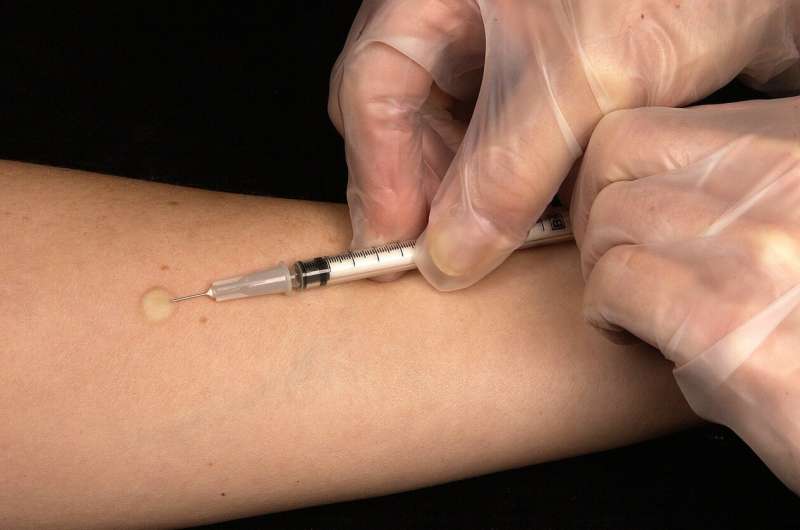This article has been reviewed according to Science X's editorial process and policies. Editors have highlighted the following attributes while ensuring the content's credibility:
fact-checked
trusted source
proofread
Tuberculosis is curable and preventable. Why do millions still die?

Tuberculosis (TB) is a curable and preventable infectious disease. And yet, more than 10 million people fall ill with it every year, and more than 1.5 million people die.
The only infectious disease to cause more deaths in recent years was COVID-19 in 2021.
The two diseases have other similarities too. Tuberculosis is also spread through the air, it mainly affects the lungs, and common symptoms include coughing, fever and fatigue. However, unlike COVID-19, research into vaccines, treatments and diagnostics for tuberculosis has been neglected for years.
And now, for the first time in over a decade, deaths caused by tuberculosis are on the rise.
Tuberculosis treatments and vaccines are getting left behind
There is only one licensed vaccine for tuberculosis: the Bacille Calmette-Guérin (BCG) vaccine.
It was invented more than 100 years ago, and while it has saved millions of lives since, it has limitations. The BCG vaccine provides protection against the most severe forms of tuberculosis in children but offers variable and limited protection for adolescents and adults.
Diagnosis and treatment rates are also low. Of the 10.6 million people estimated to have developed active tuberculosis in 2021, only about three out of five cases were appropriately diagnosed and notified.
And although tuberculosis can be cured with a combination of antibiotics, until recently, the standard course of drugs took six to nine months to complete, and treatment for drug-resistant tuberculosis took up to two years with much lower chances of cure.
New treatment options have become available in the last ten years to help tackle the growing tide of multidrug-resistant tuberculosis, reduce treatment lengths and remove toxic drugs from regimens. However, access to these drugs in many of the most deeply affected countries is limited.
So, despite being declared a global public health emergency 30 years ago, the world still faces high disease prevalence, increasing drug resistance and inadequate resources to limit further spread.
The pace of tuberculosis innovation has not matched this need—with insufficient political interest and financial investment contributing to the slow progress of research and development.
More research into tuberculosis could save millions of lives
Developing new tools to tackle this epidemic would save millions of lives. But first, we need to transform research and development for tuberculosis.
Despite world leaders setting the goal to end tuberculosis by 2030, funding for developing new diagnostic tools, vaccines and treatments falls well below the estimated US$2 billion needed every year to reach these targets.
Private sector financing has been persistently low because tuberculosis primarily impacts low- and middle-income countries—accounting for more than 80% of all cases. Tuberculosis products are not expected to secure sufficient return on investment, and as a result, industry sources only make up about 10% of the overall investment.
Vaccine development has particularly suffered. While governments spent around $90 billion on research for the COVID-19 vaccine in the first year of the pandemic, the total spent on developing a new tuberculosis vaccine is a fraction of that—just $1.1 billion in the last 11 years.
Even as newer products have been approved, these have not been equitably accessible as high prices have limited access to the communities that need them most.
After almost 50 years of limited innovation, the last decade has shown the life-saving potential if we can reinvigorate the field and ensure equitable access to new products.
For example, safer, quicker and more effective oral treatments have replaced painful injectable drugs with toxic side effects, and other new, promising drug candidates are in development.
There has also been a breakthrough in the development of a new tuberculosis vaccine. Results from the phase 2b study for the M72 vaccine candidate showed about 50% efficacy—if approved, this could prevent up to 30 million cases by 2050.
Wellcome is investing in tuberculosis research and development, focusing on the countries that are most impacted by the disease.
We want to make sure that new tools to tackle all forms of tuberculosis are developed in a way that ensures the products are accessible and affordable to the people that need them most, and with the urgency that the devastating health crisis in these communities demands.
Our infectious disease program focuses on intervening earlier with better products and tools. Our work in tuberculosis will do just that by transforming the research and development ecosystem to prioritize public health and ensure accessibility and availability for all.




















